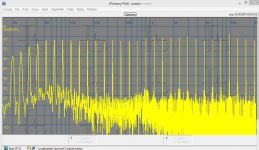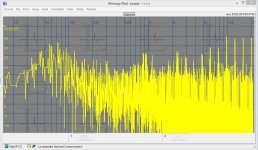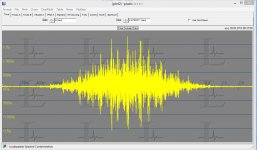Many of us seem to slowly migrate from dedicated distortion measuring equipment (HP, Tek, AP) to software based solutions based on a sound card.
One feature I always valued on the dedicated equipment was that you can look at the distortion residual, basically the waveform coming out of the fundamental rejection filter.
If you know how to interprete that residual, you can tell a lot about what is going on in the DUT.
With software/sound card solutions this feature is lost.
But does it have to be?
The software involved effortlessly switches between frequency (FFT) and time domain views.
On idea I had is this: you look at the FFT of the signal, and digitally remove whatever is in the fundamental's bin. Then you take the result, convert it back to the time domain and presto! that is the distortion residual.
You can then show it on the PC or send it out through the other soundcard analog output so you can put it on a 'scope.
As far as I know, nobody has done this. Is there a good reason why it isn't done, or is it a case that nobody thought about it yet?
Comments?
jan
One feature I always valued on the dedicated equipment was that you can look at the distortion residual, basically the waveform coming out of the fundamental rejection filter.
If you know how to interprete that residual, you can tell a lot about what is going on in the DUT.
With software/sound card solutions this feature is lost.
But does it have to be?
The software involved effortlessly switches between frequency (FFT) and time domain views.
On idea I had is this: you look at the FFT of the signal, and digitally remove whatever is in the fundamental's bin. Then you take the result, convert it back to the time domain and presto! that is the distortion residual.
You can then show it on the PC or send it out through the other soundcard analog output so you can put it on a 'scope.
As far as I know, nobody has done this. Is there a good reason why it isn't done, or is it a case that nobody thought about it yet?
Comments?
jan
You'd need to keep the phase part of the FFT too, without the phase the value of the residual as a diagnostic is somewhat diminished. Also there's no one bin for the fundamental, its smeared out by the windowing function. That is unless the sample rate clock is locked to the test tone fundamental, which is entirely possible if the test tone DAC and the ADC are on the same soundcard.
You'd need to keep the phase part of the FFT too, without the phase the value of the residual as a diagnostic is somewhat diminished.
Right. But that is not a real problem, is it?
Also there's no one bin for the fundamental, its smeared out by the windowing function. That is unless the sample rate clock is locked to the test tone fundamental, which is entirely possible if the test tone DAC and the ADC are on the same soundcard.
Yes I realised that. I guess that too is not a real issue, but must be safeguarded in the software. For instance, one software I tested (can't remember the name at the moment) has a setting where you lock the two and also size the FFT to make it totally synchronous, no window needed.
Edit: I believe Virtins has the synchronous option.
jan
Last edited:
No, keeping the phase of the FFT isn't any kind of problem.
I'm wondering though given the need for phase locking the SR to shoe-horn the fundamental into just the one bin whether there's any role for FFT at all. Since the time sequence is what's already acquired, why not just subtract the invFFT of the fundamental from that (still in the time domain) to get the residual directly? This just needs measuring the precise amplitude and phase of the fundamental to get a null.
I'm wondering though given the need for phase locking the SR to shoe-horn the fundamental into just the one bin whether there's any role for FFT at all. Since the time sequence is what's already acquired, why not just subtract the invFFT of the fundamental from that (still in the time domain) to get the residual directly? This just needs measuring the precise amplitude and phase of the fundamental to get a null.
Something like this maybe:
....the filtering of a FFT filter is not done in time domain. Instead, the input signal is transformed from time domain to frequency domain using FFT, its spectrum is then multiplied with the filter’s frequency response and the result is transformed back to time domain using inverse FFT.
jan
....the filtering of a FFT filter is not done in time domain. Instead, the input signal is transformed from time domain to frequency domain using FFT, its spectrum is then multiplied with the filter’s frequency response and the result is transformed back to time domain using inverse FFT.
jan
I built a subcircut for LTspice: http://www.diyaudio.com/forums/software-tools/101810-spice-simulation-37.html#post1333137
I assume Audio DiffMaker wouldn't have any trouble with sine wave input
I assume Audio DiffMaker wouldn't have any trouble with sine wave input
LTspice does have .wav I/O - can simultaneously play and record with Audacity - digital sine .wav can be generated in either, with same soundcard DAC/ADC using a common clock sync shouldn't be a problem
but I expect the Liberty Insturments free DiffMaker sw would do a better job with a deeper null
but I expect the Liberty Insturments free DiffMaker sw would do a better job with a deeper null
Last edited:
Besides saving phase information u may have to save negative time information.Many of us seem to slowly migrate from dedicated distortion measuring equipment (HP, Tek, AP) to software based solutions based on a sound card.
One feature I always valued on the dedicated equipment was that you can look at the distortion residual, basically the waveform coming out of the fundamental rejection filter.
If you know how to interprete that residual, you can tell a lot about what is going on in the DUT.
With software/sound card solutions this feature is lost.
But does it have to be?
The software involved effortlessly switches between frequency (FFT) and time domain views.
On idea I had is this: you look at the FFT of the signal, and digitally remove whatever is in the fundamental's bin. Then you take the result, convert it back to the time domain and presto! that is the distortion residual.
You can then show it on the PC or send it out through the other soundcard analog output so you can put it on a 'scope.
As far as I know, nobody has done this. Is there a good reason why it isn't done, or is it a case that nobody thought about it yet?
Comments?
jan
This information is thrown out and often considered useless, but it is needed to go back and forth.
Also u must remember to do a reverse FFT rather than another forward FFT.
Otherwise, u end up with a cepstrum response.
Jan, i do something similar with speakers. I put in a 30 tone signal and suppress the fundamentals.
Then i make an Invers FFT and have the residual in the time domain.
I can then make a WAV and listen.
I call it the Gerhard Test in search of a better name for it.
I can post a WAV how that sounds.
Then i make an Invers FFT and have the residual in the time domain.
I can then make a WAV and listen.
I call it the Gerhard Test in search of a better name for it.
I can post a WAV how that sounds.
Here are the measurements of a good quality wideband driver and the distortion risidual to multitone stimulation as WAV.
Attachments
Steven, no. As far as i can tell i am the only one that uses that method. I also helped Bill Waslo with his Distortion Isolation method. Actually i had the idea and Bill did the implementation. I also did the trouble shooting. Maybe this is something to wright up in Jans Linear Audio.
The scale is in Micro Pascal so the distortion is miniscule in absolute terms but quite anoying when you here the WAV. This is a very high quality speaker. Other distort more.
The scale is in Micro Pascal so the distortion is miniscule in absolute terms but quite anoying when you here the WAV. This is a very high quality speaker. Other distort more.
- Status
- This old topic is closed. If you want to reopen this topic, contact a moderator using the "Report Post" button.
- Home
- Design & Build
- Equipment & Tools
- Time-view of distortion residual


